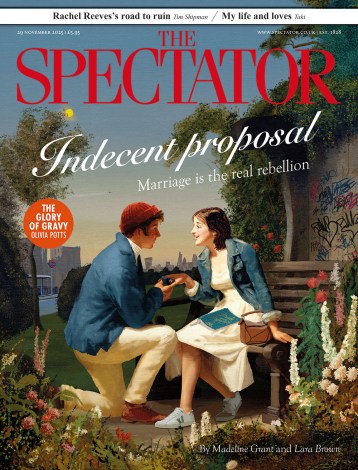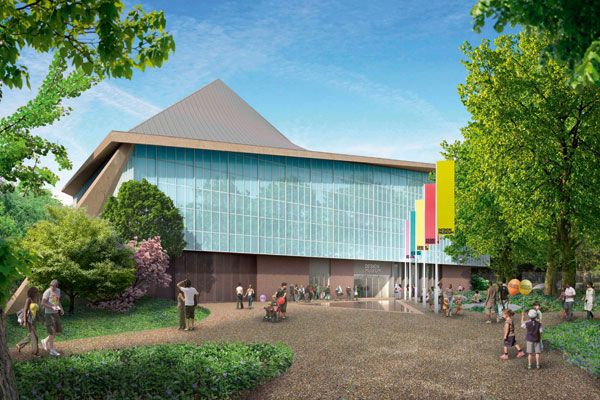Twenty-five years ago I went to St James’s Palace to ask the Prince of Wales if he would open the new Design Museum. Before us was the model of the building, an elegant, austere, uncompromised white box that was very much along Bauhaus lines. We knew that ‘modern’ no longer meant ‘of-the-moment’ but had become a period style label. Even at the time we acknowledged the layers of irony in this historicist gesture. The Prince, sounding pained, I recall, asked, ‘Mr Bayley, why has it got a flat roof?’ And that was the end of that.
Next time it will be different. The Design Museum is moving from a creatively reused banana warehouse near Tower Bridge to a creatively reused Commonwealth Institute on the edge of Holland Park. For those inclined to see symbolism in such things, there is symbolism here. Prince Charles has not (yet) been asked to officiate at the 2015 opening ceremony, but he will surely approve of the hyperbolic paraboloid roof: a frank denial of old-fashioned rationalism.
The architectural profile of the new Design Museum hints at the more complex realities of the 21st century. The original Design Museum was built to meet philosophically simple needs. Twenty-five years ago, design was not taken seriously — if it was taken at all. The Design Museum was established to remedy that. Terence Conran had provided the money and inspiration, I the chutzpah and the graft.
In its idealism and innocence, it was an unashamedly modernistic project, as the lucid geometry of the building suggested. We knew with absolute clarity what we wanted. Clean lines and clear objectives were our motto. Give people the justification for wanting that elusive better salad bowl and a tubular steel cantilevered chair.
The argument had been elegantly circular. Conran, then still the owner of the popular Habitat stores with their stock of salad bowls and cantilevered chairs, had said to me: promote design on my behalf and people will buy more Habitat stuff. Then you will have ever more money to promote design. It was an idiosyncratic adventure in commerce and culture, clipping the apex of a materialist Zeitgeist with Germanic precision.
Thus Mrs Thatcher, prime minister at the time, had no difficulty in imperiously filling the royal gap left by the Prince. True, she had reservations about the antiquarian implications of ‘museum’: things of the past, or so I was lectured. And she also nagged me that there should have been a Jaguar on display, but I bit my tongue and didn’t say that it was her own industrial policies that had run that proud company to the edge of the abyss. Still, design stimulated trade and was good for business. So, a Design Museum must be a good thing.
Late last year I attended a gathering in a site hut at the end of Kensington High Street, shopping’s Appian Way. It was a deplorably cold, wet and windy day with glooping mud underfoot. My company was a group of men, mostly rather elderly, mostly one-time trustees of the original Design Museum. We had come to survey progress on the Commonwealth Institute and to wonder what might be achieved within its vast, echoing spaces: intimidating voids in the absence of the brightly lit new architectural sheen that will be added to the ribs and ruins of the past.
If I am honest, there was a bit of mystification. What exactly is the Design Museum for? I have been interrogating myself on this for a long time. Indeed, in August 1989, the day after the spectacular opening (where, ignorant of hubris, we ate miniature fish and chips in little cornets made of the FT), I sat on the Thames-side terrace and wondered what exactly we had wrought.
Since, by definition, anything that has been designed will at some point be bought and sold, special philosophical and artistic difficulties present themselves when trying to make a Design Museum look different from a shop. I am not sure we entirely succeeded, but our hearts were pure: 25 years ago the Design Museum made an important rhetorical point in isolating certain products and offering visitors a beguiling narrative about the ‘designers’ who created them. Some intellectual falsifications were involved, but then they often are in propaganda.
But in the 21st century ‘design’ is much better understood, even if the idea frustratingly evades neat definition. People appreciate that special qualities of care and forethought make some products superior to others. And while once you could mesmerise museum visitors by explaining that Charles Eames created his famous chair for Billy Wilder, today you can buy one in John Lewis. You can buy knock-offs in the back of Sunday papers. In the United States, mass-market discounter Target lays claim to design. One day even Tesco might catch on.
The relationship between shops and museums dates back to Zola’s day when Paris’s Bon Marché put the whole world on display — and offered it for sale. Delicious confusions follow. In a recent issue of the New Yorker, Paola Antonelli, the Museum of Modern Art’s influential design madam, was profiled. The context was her selecting merchandise for MoMA’s popular giftshop.
On my first visit there in 1978, this giftshop was stocked with inspiring modernist originals, a Bauhaus chess set or a Dieter Rams calculator, for example. With such goods might you dignify a home or an office. Now meretricious novelties were paraded before Antonelli’s critical eye. If there was irony in Antonelli’s method of selection, it was not apparent to the profiler. Nor this reader.
So why do we need a new museum when it is already (or soon will be) in the shops? There is an answer. Because the creation of a museum is unusual, the act carries a special polemic force. Mrs Thatcher’s scepticism about the first Design Museum was based on her objections to sentiment and history — wherever they might be found. But the Prime Minister became our accomplice in a radical agenda: putting consumer goods in a ‘museum’ made you see them in a different way. And while a shop could only give warranty details, the Design Museum offered unbiased critic appraisal.
And in 1989, in full conformity with the museum idea of identifying artists, it seemed correct to emphasise the creative genius responsible. So we had our heroes in historical figures such as Peter Behrens, Raymond Loewy and Eliot Noyes. This was a strategy that presented design as an activity with a character comparable to art. Not quite true, but a neat communications strategy that worked well.
Perhaps too well. This history of design has now been written. We know about the splendid old heroes of art and industry. Nor is there much call for new ones. The ‘designer’ fad has come and gone. The challenge now is for the Design Museum to use powerful rhetoric to get popular consciousness to the next evolutionary step of design awareness. This is not about bighead caricatures aping the process of artistic celebrity and putting their names to expensive junk, but about the culture of making things.
After all, it is the business of design to civilise manufacturing. The first Design Museum would have asked, ‘Mr Gove, do you know who designed your ministerial chair?’ The new Design Museum needs to ask, ‘Mr Gove, do you have the faintest idea how your ministerial chair was actually made?’
I know the answer: there’s work still to be done. When Cabinet ministers understand drop-forging, layered composites, stereo-lithography and regulated metal deposition, it will be time for a third-generation Design Museum. Meanwhile, we can forget about Charles Eames.






Comments